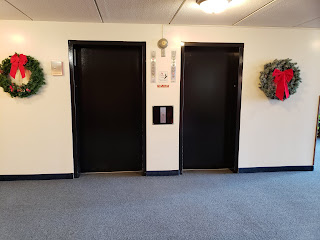Controller
– Smartrise Engineering
Fixtures
– Innovation Industries
Door
equipment – GAL Manufacturing
Power
units – MEI/Minnesota Elevator
Roller
guides – Elsco
Cylinders
– EECO/Elevator Equipment Corporation
Machine
room layout – While the new equipment is wonderful, the area the new machine
room layout gives the elevator mechanic is a game changer. Since we have so much room the building
decided to put Milton from Office Space's temporary work station in the elevator machine room. I let the building know that the work station had to go as it cannot be in the elevator machine room, even if his stapler is in there.
Old machine room layout
New machine room layout
Controllers
– The existing controllers where Westinghouse relay logic from the original
construction of the building. We replaced them with Smartrise Engineering’s
hydraulic elevator control system.
Old Westinghouse hydraulic control system
New Smartrise Engineering control system
Fixtures
– The existing fixtures where standard Westinghouse. The new replacement fixtures are from
Innovation Industries.
Old Westinhouse car station
New Innovation Industries car station
Old main lobby hall station - Multi light position indicators
New main lobby hall station - Digital position indicators
Power
units – The old power units where old Westinghouse dry units with UV7 valves on
them. The replacement power units where
manufactured by Minnesota Elevator and utilizes Maxton UC4 valves.
Old EECO valve
New Maxton Valve
Cylinders
– All 4 elevators had the original cylinders from DL Martin/Westinghouse. The owner wanted to remove them so there
would be piece of mind and no potential for cylinder failure in the
future.
Old Westinghouse/DL Martin cylinder
New EECO elevator cylinder
Take
away – From start to finish this was team effort. The GC was great, the building owner was
patient and understanding throughout the whole project. Our project team was awesome! Without the sales guy there is no project, without
the elevator installation personnel there is no project, without the engineer
there is no project, without the project manager things don’t go as smooth, without
the delivery/prep team there are big time line challenges, without the office
support staff to do billing and certified payroll the company doesn’t get paid. Execution on all parts of this was tremendous
and I’m lucky to have been 1 of 15 people from Colley Elevator to have been
part of this project! Thank you to everyone
involved!
If
you have any questions or would like additional information feel free to
contact me at CraigZ@colleyelevator.com or
630-766-7230 ext. 107.
Also
check us out on Instagram @Colleyelevator see what we have been up to.



























